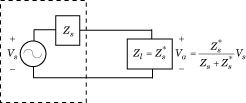s2tf
Convert S-parameters of 2-port network to voltage or power-wave transfer function
Syntax
Description
tf = s2tf(sparams_obj)hs, into the voltage transfer
function of the network.
tf = s2tf(sparams_obj,zs,zl)zs,
and load impedance zl.
tf = s2tf(sparams_obj,zs,zl,option)option.
Examples
Input Arguments
Output Arguments
Algorithms
The following figure shows the setup for computing the transfer function, along with the impedances, voltages, and the power waves used to determine the gain.

The function uses the following voltages and power waves for calculations:
Vl is the output voltage across the load impedance.
Vs is the source voltage.
Vin is the input voltage of the 2-port network.
is the incident power wave, equal to .
is the transmitted power wave, equal to .
References
[1] Gonzalez, Guillermo. Microwave Transistor Amplifiers: Analysis and Design. 2nd ed, Prentice Hall, 1997.
Version History
Introduced in R2006b
